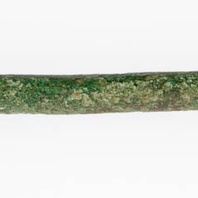
Viking Objects
Copper-Alloy Needle (CM. 1845-2008)
A cylindrical copper-alloy needle fragment with a broken shaft. Needles were a common textile tool and could be made from bone, metal or wood. They are usually associated with women and finds like this indicate that the inhabitants of the Viking camp at Torksey included women and children alongside the warriors of the Great Heathen Army.
Read More
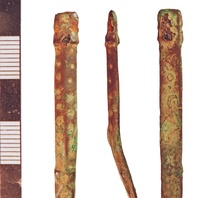
Viking Objects
Stamped Copper-Alloy Casket Mount (NLM-9B6A0B)
A stamped copper alloy casket mount found decorated with stamped ring and dot pattern decoration. Ring and dot pattern was found to be diagnostic of early medieval occupation at Cottam in the East Riding of Yorkshire, and this provides dating evidence for this piece.
Read More
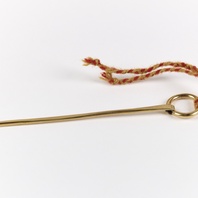
Viking Objects
Reproduction Ring-Headed Pin
A reproduction ring-headed pin used for fastening cloaks. Pins like this were common in Ireland and the western British Isles, and spread further afield under Viking influence.
Read More
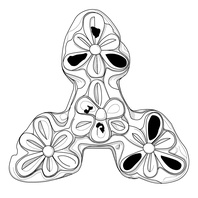
Viking Designs
Drawing of a Carolingian Trefoil Mount
Drawing of a copper alloy and gilded Carolingian mount with niello inlay found in Leicestershire. The mount has holes drilled through it for affixing to a surface, possibly a book, or perhaps to repurpose it as a pendant.
Read More
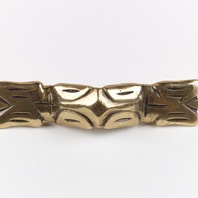
Viking Objects
Reproduction Ansate Brooch
A reproduction, copper alloy, ansate brooch based on an example from York. Two copper alloy examples of ansate brooches, also known as equal-armed brooches, were found at 16-22 Coppergate. These brooches are characterised by a narrow arched bow and terminal heads of identical form. The design of the brooches from Coppergate are a variant known as ‘caterpillar’ type. Asnate brooches are dated to between the seventh and ninth centuries though the finds at Coppergate may extend their popularity into the tenth century. The ‘caterpillar’ variety is typically geographically limited to areas bordering the North Sea. The quantity found in England, however, may indicate local manufacture. Brooches were a typical part of female dress. Scandinavian brooches came in a variety of sizes and shapes which included disc, trefoil, lozenge, equal-armed, and oval shapes. The different brooch types served a variety of functions in Scandinavian female dress with oval brooches typically being used as shoulder clasps for apron-type dresses and the rest being used to secure an outer garment to an inner shift. Anglo-Saxon brooches do not match this diversity of form with large disc brooches being typical of ninth century dress styles with smaller ones becoming more popular in the later ninth and tenth centuries. However, since disc brooches were used by both Anglo-Saxon and Scandinavian women they are distinguished by their morphology. Scandinavian brooches were typically domed with a hollow back while Anglo-Saxon brooches were usually flat. Moreover, Anglo-Saxon brooches were worn singly without accompanying accessories.
Read More
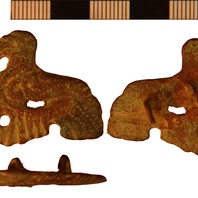
Viking Objects
Viking Bird Brooch (NLM-612074)
This brooch is classified as Weetch’s type 30.C and is decorated with an openwork design representing a bird in profile. For more information on Scandinavian jewellery in England check out our blog: Brooches, Pendants and Pins: Scandinavian Dress Accessories in England.
Read More
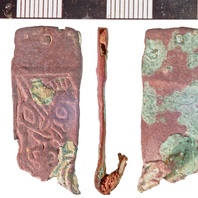
Viking Objects
Borre-Style Strap-End (NLM-F4E3D9)
This strap-end is classified as a Thomas Class E type 4 with Borre-style decoration. Strap-ends came in various styles and were fairly common throughout the Viking world. They were used to decorate the ends of belts and to stop them getting damaged.
Read More
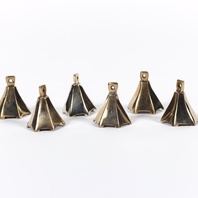
Viking Objects
Reproduction Norse Bells
Bells of this type are described as a ‘Norse’ bell because of their association with Scandinavian sites though not much else is known about their purpose or origin. However, it seems likely that they were used as harness decorations.
Read More
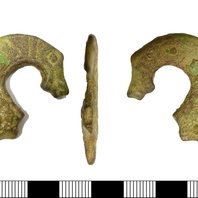
Viking Objects
Copper-Alloy Bridle Bit (LEIC-069A75)
This cast copper-alloy bridle bit fragment is made up of a flat curved section which terminates in a sub-rectangular beast’s stylised head above a ‘trefoil’-shaped projection decorated with an incised spiral motif.
Read More
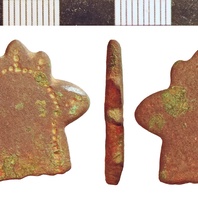
Viking Objects
Bridle Bit (NLM-4CB914)
This bridle bit plate is decorated with rounded protrusions from its edges, apparently representing the head of a beast combining attributes of horse and dragon. The reddish tint of the metal is a common feature of Anglo-Scandinavian metalwork.
Read More
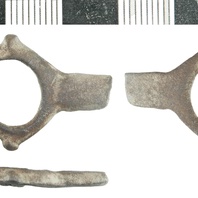
Viking Objects
Harness Fitting (NLM-0C6D7D)
This copper-alloy harness-link fragment consists of a rhomboid loop and the stub of a lentoid section bar. The metal has a reddish tint often associated with Anglo-Scandinavian material.
